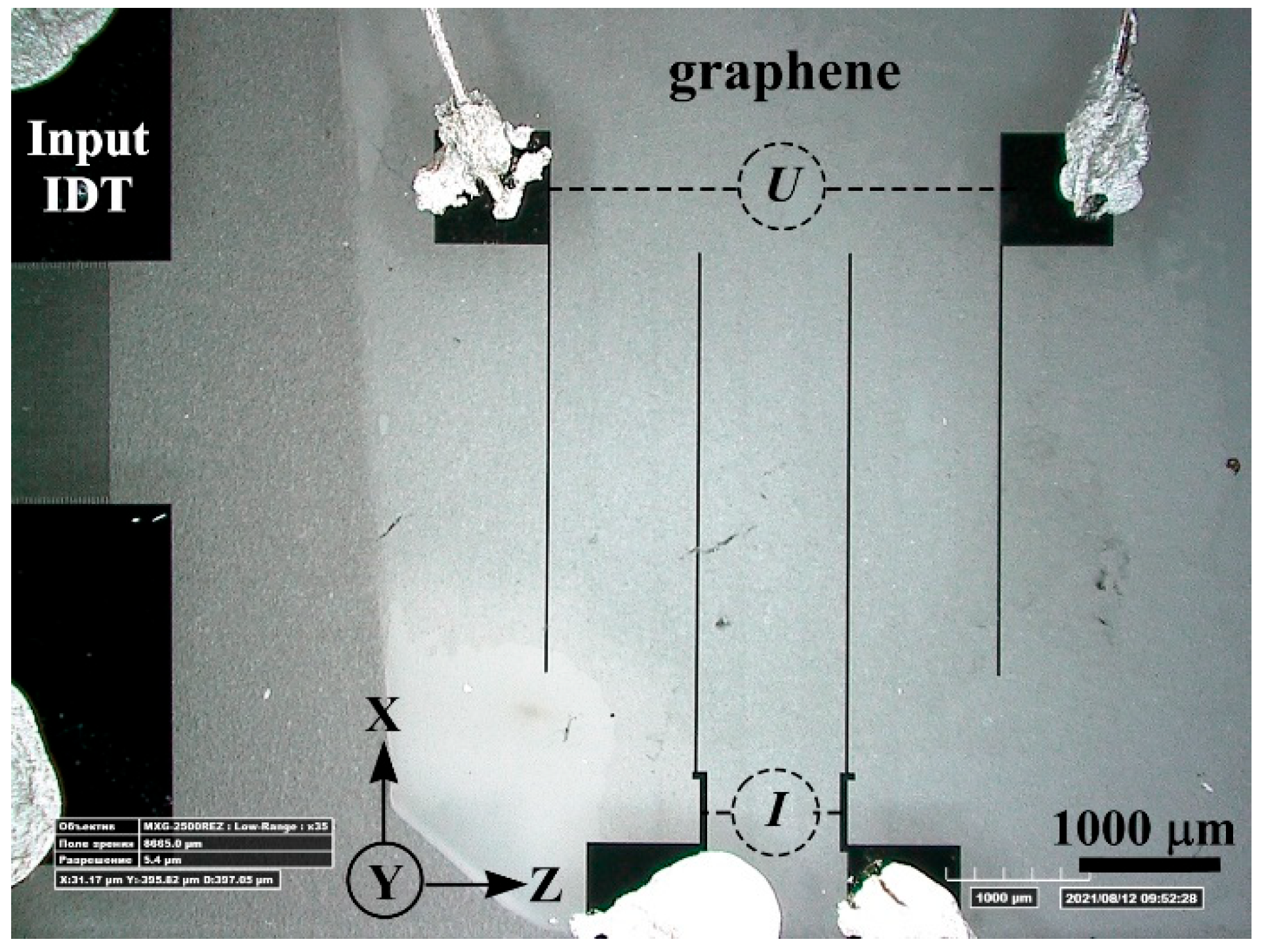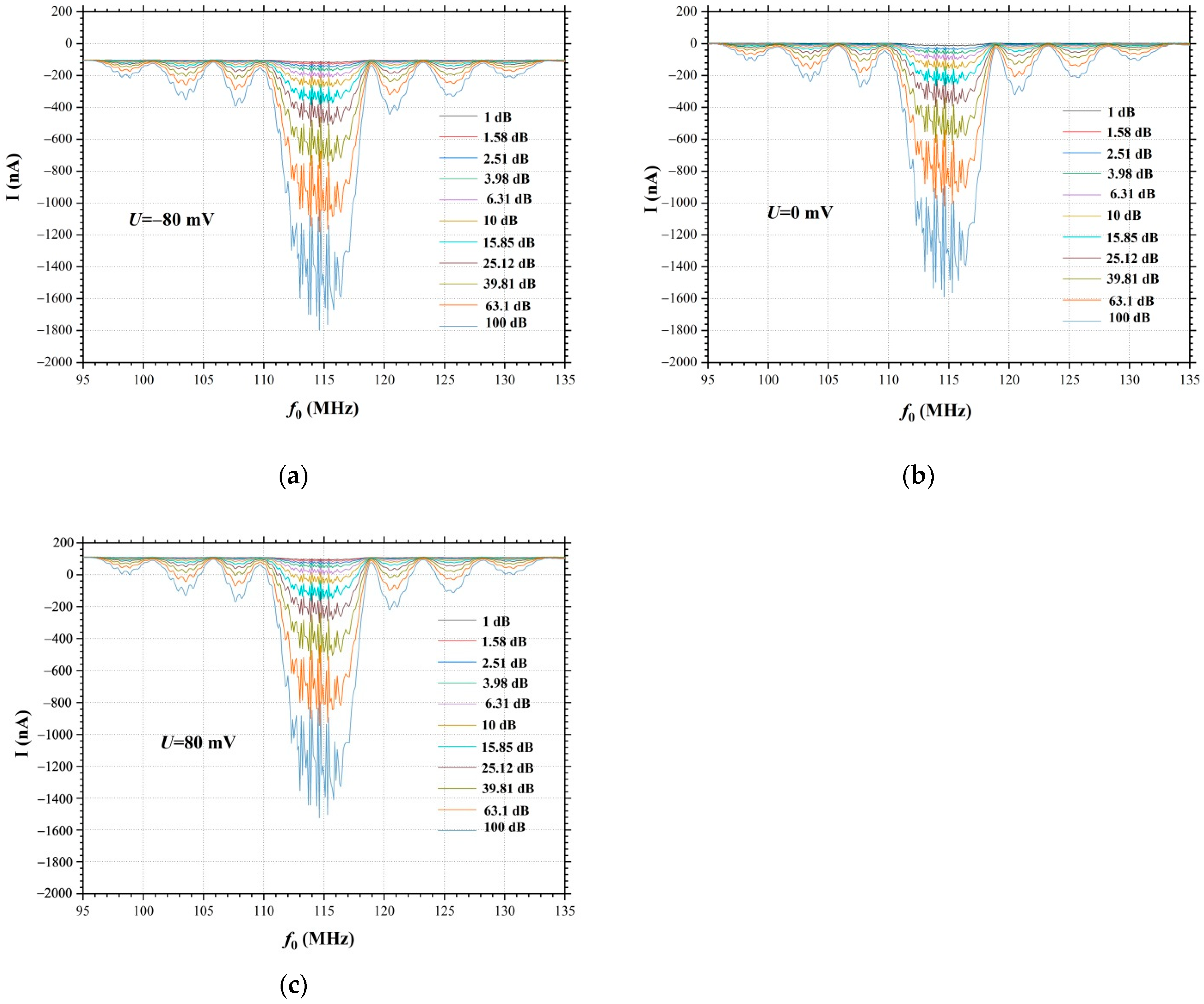Acoustically Stimulated Charge Transport in Graphene Film
Abstract
:1. Introduction
2. Fabrication of Graphene/LiNbO3 SAW Delay Time Line
3. Investigation of SAW Propagation in Graphene Film by Scanning Electron Microscopy Method
4. Investigation of Acoustically Stimulated Charge Transport in Graphene Film
5. Transport of Photo-Stimulated Charges in a Graphene Film by Surface Acoustic Waves
6. Conclusions
Author Contributions
Funding
Data Availability Statement
Conflicts of Interest
References
- Campbell, C. Surface Acoustic Wave Devices and Their Signal Processing Applications; Academic Press: San Diego, CA, USA, 1989; pp. 1–470. [Google Scholar]
- Priya, R.B.; Venkatesan, T.; Pandiyarajan, G.; Pandya, H.M. A short review of SAW sensors. J. Environ. Nanotechnol. 2015, 4, 15–22. [Google Scholar]
- Liu, J.; Wang, W.; Li, S.; Liu, M.; He, S. Advances in SAW Gas Sensors Based on the Condensate-Adsorption Effect. Sensors 2011, 11, 11871–11884. [Google Scholar] [CrossRef]
- Wingqvist, G.; Yantchev, V.; Katardjiev, I. Mass sensitivity of multilayer thin film resonant BAW sensors. Sens. Actuators A 2008, 148, 88–95. [Google Scholar] [CrossRef]
- Leong, A.; Seeneevassen, S.; Saha, T.; Swamy, V.; Ramakrishnan, N. Low hysteresis relative humidity sensing characteristics of graphene oxide–gold nanocomposite coated langasite crystal microbalance, Surf. Interfaces 2021, 23, 100964. [Google Scholar]
- Sahaa, T.; Guo, N.; Ramakrishnan, N. A novel langasite crystal microbalance instrumentation for UV sensing application. Sens. Actuators A 2016, 252, 16–25. [Google Scholar] [CrossRef]
- Chen, C.; Jin, J. Surface Acoustic Wave Vapor Sensor with Graphene Interdigital Transducer for TNT Detection. Sens. Imaging 2020, 21, 24. [Google Scholar] [CrossRef]
- Varghesea, S.S.; Lonkar, S.; Singh, K.K.; Swaminathan, S.; Abdala, A. Recent advances in graphene based gas sensors. Sens. Actuators B 2015, 218, 160–183. [Google Scholar] [CrossRef]
- Lupana, O.; Ursaki, V.V.; Chai, G.; Chowa, L.; Emelchenkoe, G.A.; Tiginyanug, I.M.; Gruzintsev, A.N.; Redkin, A.N. Selective hydrogen gas nanosensor using individual ZnO nanowire with fast response at room temperature. Sens. Actuators B 2010, 144, 56–66. [Google Scholar] [CrossRef]
- Roshchupkin, D.; Redkin, A.; Emelin, E.; Sakharov, S. Ultraviolet Radiation Sensor Based on ZnO Nanorods/La3Ga5SiO14 Microbalance. Sensors 2021, 21, 4170. [Google Scholar] [CrossRef]
- Rocke, C.; Zimmermann, S.; Wixforth, A.; Kptthaus, J.P.; Böhm, G.; Weimann, G. Acoustically Driven Storage of Light in a Quantum Well. Phys. Rev. Lett. 1997, 78, 4099. [Google Scholar] [CrossRef] [Green Version]
- Batista, P.D.; Hey, R.; Santos, P.V. Efficient electrical detection of ambipolar acoustic transport in GaAs. Appl. Phys. Lett. 2008, 92, 262108. [Google Scholar] [CrossRef]
- Jiao, S.J.; Batista, P.D.; Biermann, K.; Hey, R.; Santos, P.V. Electrical detection of ambipolar acoustic carrier transport by surface acoustic waves. J. Appl. Phys. 2009, 106, 053708. [Google Scholar] [CrossRef]
- Yakovenko, V.M. Novel method for photovoltaic energy conversion using surface acoustic waves in piezoelectric semiconductors. Phys. B 2012, 407, 1969–1972. [Google Scholar]
- Novoselov, K.S.; Geim, A.K.; Morozov, S.V.; Jiang, D.; Katsnelson, M.I.; Grigorieva, I.V.; Dubonos, S.V.; Firsov, A.A. Two-dimensional gas of massless Dirac fermions in graphene. Nature 2005, 438, 197. [Google Scholar] [CrossRef] [Green Version]
- Katsnelson, M.I.; Novoselov, K.S. Graphene: New Bridge between Condensed Matter Physics and Quantum Electrodynamics. Solid State Commun. 2007, 143, 3–13. [Google Scholar] [CrossRef] [Green Version]
- Miseikis, V.; Cunningham, J.E.; Saeed, K.; O’Rorke, R.; Davies, A.G. Acoustically induced current flow in graphene. Appl. Phys. Lett. 2012, 100, 133105. [Google Scholar] [CrossRef]
- Poole, T.; Nash, G.R. Acoustoelectric Current in Graphene Nanoribbons. Sci. Rep. 2017, 7, 1767. [Google Scholar] [CrossRef] [Green Version]
- Santos, P.V.; Schumann, T.; Oliveira Jr., M.H.; Lopes, J.M.J.; Riechert, H. Acousto-electric transport in epitaxial monolayer graphene on SiC. Appl. Phys. Lett. 2013, 102, 221907. [Google Scholar] [CrossRef] [Green Version]
- Insepov, Z.; Emelin, E.; Kononenko, O.; Roshchupkin, D.V.; Tnyshtykbayev, K.B.; Baigarin, K.A. Surface acoustic wave amplification by direct current-voltage supplied to graphene film. Appl. Phys. Lett. 2015, 106, 023505. [Google Scholar] [CrossRef] [Green Version]
- Mayorov, A.S.; Hunter, N.; Muchenje, W.; Wood, C.D.; Rosamond, M.; Linfield, E.H.; Davies, A.G.; Cunningham, J.E. Surface acoustic wave generation and detection using graphene interdigitated transducers on lithium niobate. Appl. Phys. Lett. 2014, 104, 083509. [Google Scholar] [CrossRef]
- Roshchupkin, D.; Ortega, L.; Zizak, I.; Plotitcyna, O.; Matveev, V.; Kononenko, O.; Emelin, E.; Erko, A.; Tynyshtykbayev, K.; Irzhak, D.; et al. Surface acoustic wave propagation in graphene film. J. Appl. Phys. 2015, 118, 104901. [Google Scholar] [CrossRef]
- Emelin, E.; Cho, H.D.; Insepov, Z.; Lee, J.C.; Kang, T.W.; Panin, G.; Roshchupkin, D.; Tynyshtykbayev, K. SEM imaging of acoustically stimulated charge transport in solids. Appl. Phys. Lett. 2017, 110, 264103. [Google Scholar] [CrossRef]
- Poole, T.; Nash, G.R. Acoustoelectric photoresponse of graphene nanoribbons. J. Phys. D Appl. Phys. 2018, 51, 154001. [Google Scholar] [CrossRef]
- Kononenko, O.V.; Emelin, E.V.; Matveev, V.N.; Roshchupkin, D.V. Photoresponse in Multilayer Graphene during the Passage of a Surface Acoustic Wave. Tech. Phys. Lett. 2020, 46, 220–223. [Google Scholar] [CrossRef]
- Ferrari, A.C.; Basko, D.M. Raman spectroscopy as a versatile tool for studying the properties of graphene. Nat. Nanotechnol. 2013, 8, 235–246. [Google Scholar] [CrossRef] [Green Version]
- Ferrari, A.C.; Meyer, J.C.; Scardaci, V.; Casiraghi, C.; Lazzeri, M.; Mauri, F.; Piscanec, S.; Jiang, D.; Novoselov, K.S.; Roth, S.; et al. Raman spectrum of graphene and graphene layers. Phys. Rev. Lett. 2006, 97, 187401. [Google Scholar] [CrossRef] [Green Version]
- Eberharter, G.; Feuerbaum, H.P. Scanning-elctron-microscope observations of propagating acoustic waves in surface acoustic wave devices. Appl. Phys. Lett. 1980, 37, 698. [Google Scholar] [CrossRef]
- Roshchupkin, D.V.; Brunel, M. Scanning electron microscopy observation of surface acoustic wave propagation in the LiNbO3 crystals with regular domain structures. IEEE Trans. Ultrason. Ferroelectr. Freq. Control 1994, 41, 512–517. [Google Scholar] [CrossRef]
- Roshchupkin, D.; Emelin, E.; Plotitcina, O.; Mololkin, A.; Telminov, O. Scanning Electron Microscopy Investigation of Surface Acoustic Wave Propagation in a 41° YX-Cut of a LiNbO3 Crystal/Si Layered Structure. Crystals 2021, 11, 1082. [Google Scholar] [CrossRef]








Publisher’s Note: MDPI stays neutral with regard to jurisdictional claims in published maps and institutional affiliations. |
© 2022 by the authors. Licensee MDPI, Basel, Switzerland. This article is an open access article distributed under the terms and conditions of the Creative Commons Attribution (CC BY) license (https://creativecommons.org/licenses/by/4.0/).
Share and Cite
Roshchupkin, D.; Kononenko, O.; Fakhrtdinov, R.; Emelin, E.; Sergeev, A. Acoustically Stimulated Charge Transport in Graphene Film. Nanomaterials 2022, 12, 4370. https://doi.org/10.3390/nano12244370
Roshchupkin D, Kononenko O, Fakhrtdinov R, Emelin E, Sergeev A. Acoustically Stimulated Charge Transport in Graphene Film. Nanomaterials. 2022; 12(24):4370. https://doi.org/10.3390/nano12244370
Chicago/Turabian StyleRoshchupkin, Dmitry, Oleg Kononenko, Rashid Fakhrtdinov, Evgenii Emelin, and Alexander Sergeev. 2022. "Acoustically Stimulated Charge Transport in Graphene Film" Nanomaterials 12, no. 24: 4370. https://doi.org/10.3390/nano12244370
APA StyleRoshchupkin, D., Kononenko, O., Fakhrtdinov, R., Emelin, E., & Sergeev, A. (2022). Acoustically Stimulated Charge Transport in Graphene Film. Nanomaterials, 12(24), 4370. https://doi.org/10.3390/nano12244370







